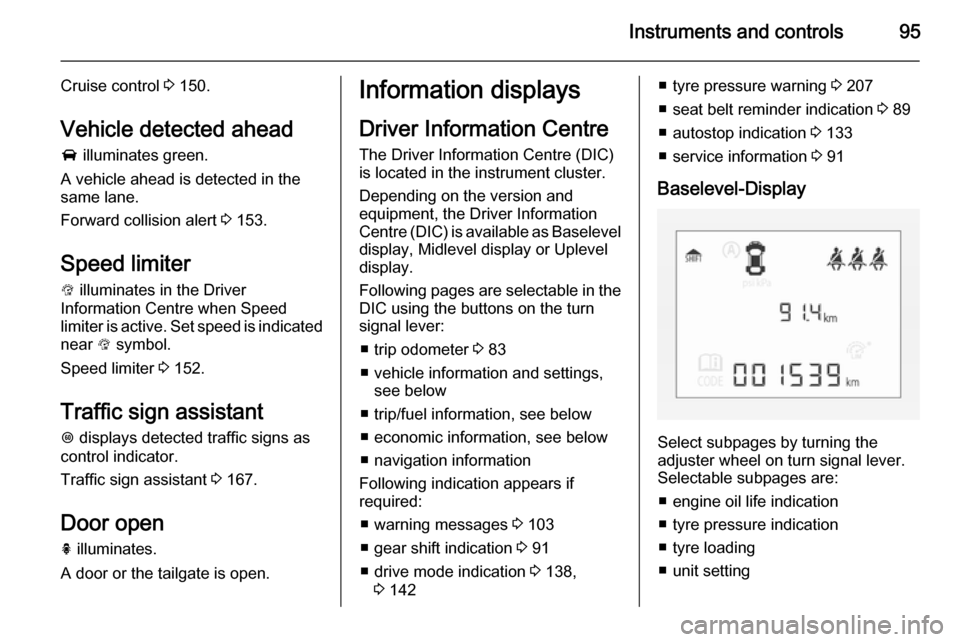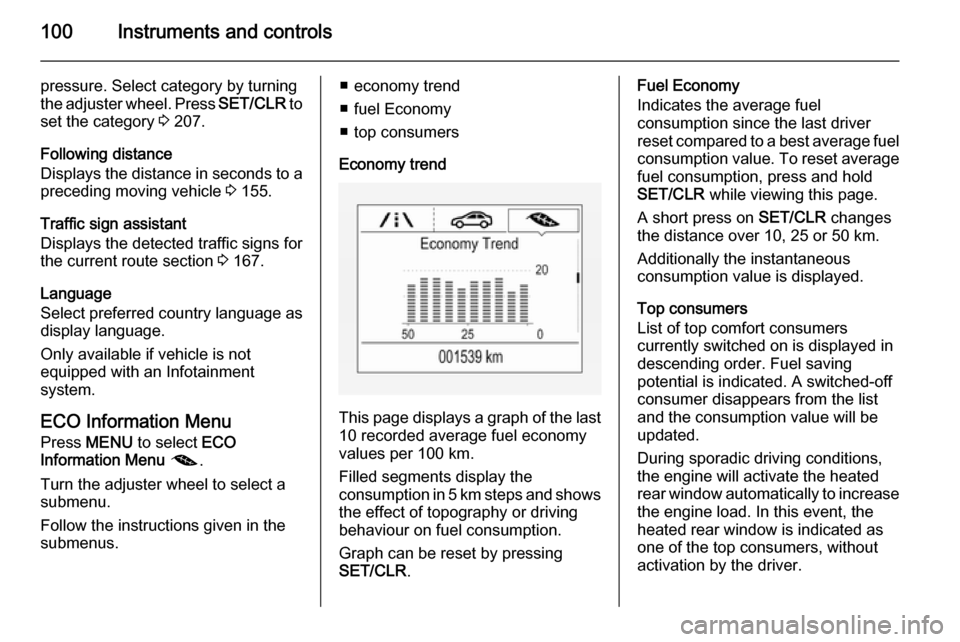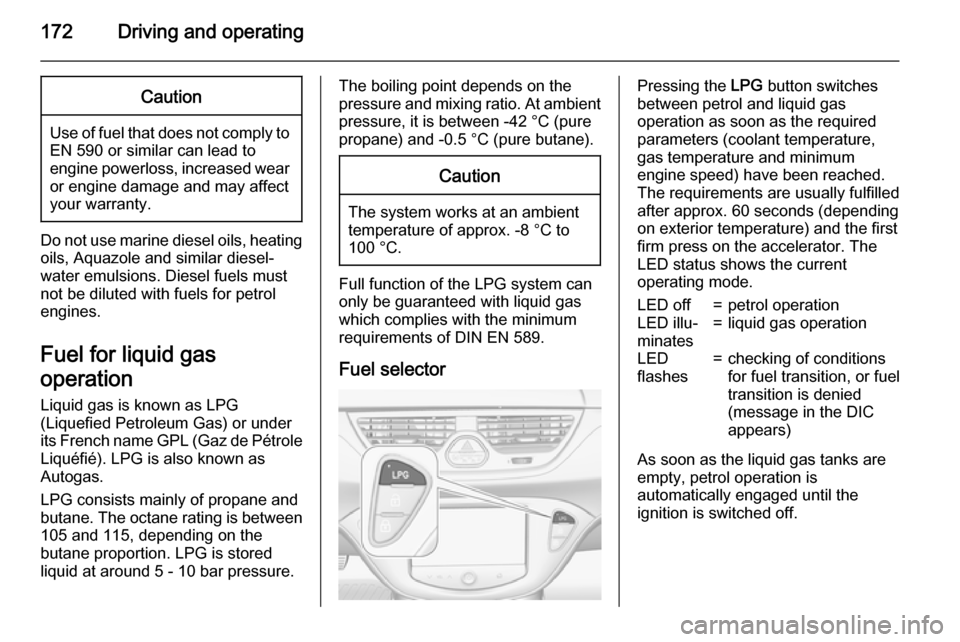fuel pressure VAUXHALL CORSA 2015.75 Owner's Manual
[x] Cancel search | Manufacturer: VAUXHALL, Model Year: 2015.75, Model line: CORSA, Model: VAUXHALL CORSA 2015.75Pages: 261, PDF Size: 7.61 MB
Page 97 of 261

Instruments and controls95
Cruise control 3 150.
Vehicle detected ahead A illuminates green.
A vehicle ahead is detected in the
same lane.
Forward collision alert 3 153.
Speed limiter L illuminates in the Driver
Information Centre when Speed
limiter is active. Set speed is indicated near L symbol.
Speed limiter 3 152.
Traffic sign assistant
L displays detected traffic signs as
control indicator.
Traffic sign assistant 3 167.
Door open h illuminates.
A door or the tailgate is open.Information displays
Driver Information Centre The Driver Information Centre (DIC)
is located in the instrument cluster.
Depending on the version and
equipment, the Driver Information
Centre (DIC) is available as Baselevel
display, Midlevel display or Uplevel
display.
Following pages are selectable in the DIC using the buttons on the turn
signal lever:
■ trip odometer 3 83
■ vehicle information and settings, see below
■ trip/fuel information, see below ■ economic information, see below
■ navigation information
Following indication appears if
required:
■ warning messages 3 103
■ gear shift indication 3 91
■ drive mode indication 3 138,
3 142■ tyre pressure warning 3 207
■ seat belt reminder indication 3 89
■ autostop indication 3 133
■ service information 3 91
Baselevel-Display
Select subpages by turning the
adjuster wheel on turn signal lever.
Selectable subpages are:
■ engine oil life indication
■ tyre pressure indication
■ tyre loading
■ unit setting
Page 102 of 261

100Instruments and controls
pressure. Select category by turning
the adjuster wheel. Press SET/CLR to
set the category 3 207.
Following distance
Displays the distance in seconds to a
preceding moving vehicle 3 155.
Traffic sign assistant
Displays the detected traffic signs for
the current route section 3 167.
Language
Select preferred country language as
display language.
Only available if vehicle is not
equipped with an Infotainment
system.
ECO Information Menu
Press MENU to select ECO
Information Menu @ .
Turn the adjuster wheel to select a
submenu.
Follow the instructions given in the
submenus.■ economy trend
■ fuel Economy
■ top consumers
Economy trend
This page displays a graph of the last 10 recorded average fuel economy
values per 100 km.
Filled segments display the
consumption in 5 km steps and shows
the effect of topography or driving
behaviour on fuel consumption.
Graph can be reset by pressing
SET/CLR .
Fuel Economy
Indicates the average fuel
consumption since the last driver
reset compared to a best average fuel
consumption value. To reset average fuel consumption, press and hold
SET/CLR while viewing this page.
A short press on SET/CLR changes
the distance over 10, 25 or 50 km.
Additionally the instantaneous
consumption value is displayed.
Top consumers
List of top comfort consumers
currently switched on is displayed in
descending order. Fuel saving
potential is indicated. A switched-off
consumer disappears from the list
and the consumption value will be
updated.
During sporadic driving conditions,
the engine will activate the heated
rear window automatically to increase
the engine load. In this event, the
heated rear window is indicated as
one of the top consumers, without
activation by the driver.
Page 106 of 261

104Instruments and controls
No.Vehicle message27Right front turn signal failure28Right rear turn signal failure29Check trailer brake light30Check trailer reversing light31Check left trailer turn signal32Check right trailer turn signal33Check trailer rear fog light34Check trailer rear light35Replace battery in radio remote
control48Clean side blind spot alert
system49Lane departure warning
unavailable53Tighten gas cap54Water in diesel fuel filter55Diesel particle filter is full
3 136No.Vehicle message56Tyre pressure imbalance on
front axle57Tyre pressure imbalance on
rear axle58Tyres without TPMS sensors
detected59Open and then close driver
window60Open and then close front
passenger window65Theft attempted66Service theft alarm system67Service steering wheel lock68Service power steering75Service air conditioning76Service side blind spot alert
system79Top up engine oil81Service transmissionNo.Vehicle message82Change engine oil soon84Engine power reduced89Service vehicle soon94Shift to park before exiting95Service airbag128Bonnet open134Park assist fault, clean bumper136Service parking assist145Check washer fluid level174Low vehicle battery258Park assist off
Vehicle messages on Uplevel-
Display The vehicle messages are displayedas text. Follow the instructions given
in the messages.
Page 132 of 261

130Driving and operatingDriving and operatingDriving hints............................... 130
Starting and operating ...............131
Engine exhaust .......................... 136
Automatic transmission .............. 138
Manual transmission ..................141
Manual transmission automa‐
ted .............................................. 142
Brakes ........................................ 145
Ride control systems .................147
Driver assistance systems .........150
Fuel ............................................ 171
Trailer hitch ................................ 177Driving hints
Control of the vehicleNever coast with engine not
running
Many systems will not function in this
situation ( e.g. brake servo unit, power
steering). Driving in this manner is a
danger to yourself and others.
All systems function during an
Autostop.
Stop-start system 3 133.
Idle boost
If charging of the vehicle battery is
required due to battery condition, the
power output of the generator must be increased. This will be achieved by
an idle boost which may be audible.
A message appears in the Driver
Information Centre.
Pedals To ensure the pedal travel is
uninhibited, there must be no mats in
the area of the pedals.Driving downhill
Engage a gear when driving downhill to ensure that sufficient brake
pressure is available.
Page 146 of 261

144Driving and operating
Rocking the vehicleRocking the vehicle is only
permissible if the vehicle is stuck in
sand, mud or snow. Move the selector lever between R and D in a repeat
pattern. Do not race the engine and
avoid sudden acceleration.
Parking
The most recently engaged gear (see transmission display) remains
engaged when switching off ignition.
With N, no gear is engaged.
Therefore always apply the parking
brake when switching off ignition. If
parking brake is not applied, P flashes
in the transmission display and the
key cannot be removed from the
ignition switch. P stops flashing in the
transmission display as soon as the
parking brake is slightly applied.
When the ignition is switched off, the
transmission no longer responds to
movement of the selector lever.Tyre pressure monitoring
system
To start the sensor matching process of the tyre pressure monitoring
system, the selector lever must be
moved and held in position N for
five seconds. P illuminates in the
transmission display to indicate that
the sensor matching process can be
started.
Tyre pressure monitoring system
3 207.
Manual mode
If a higher gear is selected when the
engine speed is too low, or a lower
gear when the speed is too high, the
shift is not executed. This prevents
the engine from running at too low or
too high an engine speed. A warning
message is displayed in the Driver
Information Centre (DIC). Vehicle
messages 3 103.
If engine speed is too low, the
transmission automatically shifts to a
lower gear.If engine speed is too high, the
transmission only switches to a higher gear via kickdown.
When + or - is selected in automatic
mode, the transmission switches to
manual mode and shifts accordingly.
Gear shift indication The symbol R with a number
alongside it, is indicated when
gearshifting is recommended for fuel
saving reasons.
Shift indication appears only in
manual mode.
Electronic driving
programmes ■ Following a cold start, the operating
temperature programme increasesengine speed to quickly bring the
catalytic converter to the required
temperature.
■ The adaptive programme tailors gearshifting to the driving
conditions, e.g. greater load or
gradients.
Page 174 of 261

172Driving and operatingCaution
Use of fuel that does not comply toEN 590 or similar can lead to
engine powerloss, increased wear
or engine damage and may affect
your warranty.
Do not use marine diesel oils, heating
oils, Aquazole and similar diesel-
water emulsions. Diesel fuels must
not be diluted with fuels for petrol
engines.
Fuel for liquid gas
operation
Liquid gas is known as LPG
(Liquefied Petroleum Gas) or under
its French name GPL (Gaz de Pétrole Liquéfié). LPG is also known as
Autogas.
LPG consists mainly of propane and
butane. The octane rating is between
105 and 115, depending on the
butane proportion. LPG is stored
liquid at around 5 - 10 bar pressure.
The boiling point depends on the
pressure and mixing ratio. At ambient pressure, it is between -42 °C (pure
propane) and -0.5 °C (pure butane).Caution
The system works at an ambient
temperature of approx. -8 °C to
100 °C.
Full function of the LPG system can
only be guaranteed with liquid gas
which complies with the minimum
requirements of DIN EN 589.
Fuel selector
Pressing the LPG button switches
between petrol and liquid gas
operation as soon as the required
parameters (coolant temperature,
gas temperature and minimum
engine speed) have been reached.
The requirements are usually fulfilled
after approx. 60 seconds (depending
on exterior temperature) and the first
firm press on the accelerator. The
LED status shows the current
operating mode.LED off=petrol operationLED illu‐
minates=liquid gas operationLED
flashes=checking of conditions
for fuel transition, or fuel
transition is denied
(message in the DIC
appears)
As soon as the liquid gas tanks are
empty, petrol operation is
automatically engaged until the
ignition is switched off.
Page 185 of 261

Vehicle care183Vehicle careGeneral Information...................183
Vehicle checks ........................... 184
Bulb replacement .......................191
Electrical system ........................200
Vehicle tools .............................. 205
Wheels and tyres .......................206
Jump starting ............................. 224
Towing ....................................... 225
Appearance care .......................227General Information
Accessories and vehicle
modifications
We recommend the use of genuine parts and accessories and factory
approved parts specific for your
vehicle type. We cannot assess or
guarantee reliability of other products
- even if they have a regulatory or
otherwise granted approval.
Do not make any modifications to the electrical system, e.g. changes of
electronic control units (chip tuning).Caution
When transporting the vehicle on
a train or on a recovery vehicle, the
mud flaps may be damaged.
Vehicle storage
Storage for a long period of time If the vehicle is to be stored for severalmonths:
■ Wash and wax the vehicle.
■ Have the wax in the engine compartment and underbody
checked.
■ Clean and preserve the rubber seals.
■ Fill up fuel tank completely.
■ Change the engine oil.
■ Drain the washer fluid reservoir. ■ Check the coolant antifreeze and corrosion protection.
■ Adjust tyre pressure to the value specified for full load.
■ Park the vehicle in a dry, well ventilated place. Engage first orreverse gear or set selector lever to P . Prevent the vehicle from rolling.
■ Do not apply the parking brake.
Page 209 of 261

Vehicle care207
Tyre pressure 3 249.
The tyre pressure information label on the right door frame indicates the
original equipment tyres and the
correspondent tyre pressures.
The tyre pressure data refers to cold
tyres. It applies to summer and winter tyres.
The ECO tyre pressure serves to
achieve the smallest amount of fuel
consumption possible.
Incorrect tyre pressures will impair
safety, vehicle handling, comfort and
fuel economy and will increase tyre
wear.
Tyre pressures differ depending on
various options.
For the correct tyre pressure value,
follow the procedure below:
■ Identify the engine identifier code. Engine data 3 239.
■ Identify the respective tyre.
The tyre pressure tables show all possible tyre combinations 3 249.For the tyres approved for your
vehicle, refer to the EEC Certificate of
Conformity provided with your vehicle or other national registration
documents.
The driver is responsible for correct
adjustment of tyre pressure.9 Warning
If the pressure is too low, this can
result in considerable tyre warm-
up and internal damage, leading to tread separation and even to tyre
blow-out at high speeds.
If the tyre pressure must be reduced
or increased, switch off ignition. After
adjusting tyre pressure switch on
ignition and select the relevant setting on the page Tyre load in the Driver
Information Centre 3 95.
Tyre pressure monitoring
system The tyre pressure monitoring system
(TPMS) checks the pressure of all
four tyres once a minute when vehicle speed exceeds a certain limit.Caution
Tyre pressure monitoring system
warns only about low tyre pressure
condition and does not replace
regular tyre maintenance by the
driver.
All wheels must be equipped with pressure sensors and the tyres must
have the prescribed pressure.
Notice
In countries where the tyre pressure
monitoring system is legally
required, the use of wheels without
pressure sensors will invalidate the
vehicle type approval.
Page 231 of 261

Vehicle care229
Clean smearing wiper blades with a
soft cloth and window cleaner.
Remove dirt residues from smearing
wiper blades by using a soft cloth and window cleaner. Also make sure to
remove any residues such as wax,
insect residues and similar from the
window.
Ice residues, pollution and continuous
wiping on dry windows will damage or
even destroy the wiper blades.
Sunroof
Never clean with solvents or abrasive
agents, fuels, aggressive media
(e.g. paint cleaner, acetone-
containing solutions etc.), acidic or
highly alkaline media or abrasive
pads. Do not apply wax or polishing
agents to the sunroof.
Wheels and tyres
Do not use high-pressure jet
cleaners.
Clean rims with a pH-neutral wheel
cleaner.
Rims are painted and can be treated
with the same agents as the body.Paintwork damage
Rectify minor paintwork damage with
a touch-up pen before rust forms.
Have more extensive damage or rust areas repaired by a workshop.
Underbody Some areas of the vehicle underbody
have a PVC undercoating while other
critical areas have a durable
protective wax coating.
After the underbody is washed, check the underbody and have it waxed if
necessary.
Bitumen/rubber materials could
damage the PVC coating. Have
underbody work carried out by a
workshop.
Before and after winter, wash the
underbody and have the protective
wax coating checked.Liquid gas system9 Danger
Liquid gas is heavier than air and
can collect in sink points.
Take care when performing work
at the underbody in a pit.
For painting work and when using a
drying booth at a temperature above
60 °C, the liquid gas tank must be
removed.
Do not make any modifications to the
liquid gas system.
Towing equipment Do not clean the coupling ball bar with
a steam-jet or high-pressure jet
cleaner.
Rear carrier system Clean the rear carrier system with a
steam-jet or high-pressure jet cleaner
at least once a year.
Operate the rear carrier system
periodically if not in regular use, in
particular during winter.
Page 257 of 261

255
Control indicators.......................... 87
Control of the vehicle .................130
Controls ........................................ 75
Convex shape .............................. 28
Coolant and antifreeze ...............232
Corner lighting ............................ 113
Cruise control ...................... 94, 150
Cupholders .................................. 56
Curtain airbag system .................. 47
D Danger, Warnings and Cautions ...4
Daytime running lights ...............112
Declaration of conformity ............251
Diesel fuel system bleeding .......191
Diesel particle filter ...............93, 136
Door open .................................... 95
Doors ............................................ 25
Driver assistance systems ..........150
Driver Information Centre .............95
Driving characteristics and towing tips .............................. 177
Driving hints ................................ 130
E Easy entry..................................... 37
Electric adjustment ......................28
Electrical system......................... 200
Electronic climate control system 123Electronic driving programmes .
........................................ 140, 144
Electronic Stability Control.......... 148
Electronic Stability Control and Traction Control system ............92
Electronic Stability Control off....... 92 End-of-life vehicle recovery .......184
Engine compartment fuse box ...201
Engine coolant ........................... 187
Engine coolant temperature gauge ....................................... 85
Engine data ............................... 239
Engine exhaust .......................... 136
Engine identification ...................235
Engine oil ................... 185, 232, 236
Engine oil pressure ......................93
Entry lighting .............................. 118
Event data recorders ..................252
Exit lighting ................................ 118
Exterior care .............................. 227
Exterior light ................................. 94
Exterior lighting ....................12, 110
Exterior mirrors ............................. 28
F
Fault ................................... 140, 145
First aid ......................................... 72
First aid kit ................................... 72
Fixed air vents ........................... 128
Flex-Fix system ............................ 58Fog light ....................................... 94
Fog lights ................................... 195
Folding mirrors ............................. 28
Following distance indication ......155
Forward collision alert................. 153
Front airbag system .....................45
Front fog lights ........................... 115
Front seats.................................... 35
Front storage ................................ 57
Front turn signal lights ...............195
Fuel............................................. 171
Fuel consumption - CO 2-
Emissions ............................... 177
Fuel for diesel engines ..............171
Fuel for liquid gas operation .......172
Fuel for petrol engines ...............171
Fuel gauge ................................... 84
Fuel selector ................................ 85
Fuses ......................................... 200
G Gauges ......................................... 83
Gear shifting ................................. 91
General information ...................177
Glovebox ..................................... 56
Graphic-Info-Display ...................102
H Halogen headlights ....................191
Hand brake ......................... 145, 146